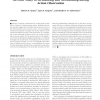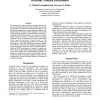41 search results - page 7 / 9 » Neural Pathways of Embodied Simulation |
CEC
2010
IEEE
13 years 5 months ago
2010
IEEE
— This work is the first attempt to investigate the neural dynamics of a simulated robotic agent engaged in minimally cognitive tasks by employing evolved instances of the Kuram...
NN
2006
Springer
13 years 5 months ago
2006
Springer
The basal ganglia (BG) coordinate decision making processes by facilitating adaptive frontal motor commands while suppressing others. In previous work, neural network simulations ...
JOCN
2011
12 years 8 months ago
2011
■ Humans commonly understand the unobservable mental states of others by observing their actions. Embodied simulation theories suggest that this ability may be based in areas of...
JMLR
2010
13 years 3 days ago
2010
Learning dynamic Bayesian network structures provides a principled mechanism for identifying conditional dependencies in time-series data. An important assumption of traditional D...
FLAIRS
2004
13 years 6 months ago
2004
The necessity for improved players and opponents in firstperson entertainment-based real-time artificial environments has inspired our research into artificial game players. We em...


